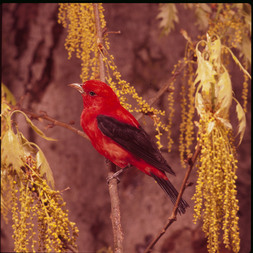 The song of the scarlet tanager has been described as like that of a robin with a sore throat. That is, there is a hoarseness or “buzziness” to the song of the scarlet tanager, but otherwise it is somewhat similar (in cadence and range, at least) to the song of the American robin.
Some of my more memorable experiences with scarlet tanagers were during summer camp with the Boy Scouts of Troop 335. Each year we traveled to Camp Rotary near Harrison, where we camped among large red and white oaks, bigtooth aspen and mature red maples. That is just the kind of forest that scarlet tanagers prefer, and there were always several males singing around the camp. I would mimic the song of a tanager, and the male in that territory would come down out of the tree canopy to within 15-20 feet of scouts and scouters who looked in amazement at the beautiful bird. For some, it was their first real exposure to the different kinds of life that are often close by but that they never notice. It was a glimpse into the world of wildlife, even in places that may be relatively “tame.”
Scarlet tanagers are birds of the tree canopy, where they hunt and feed on insects, make their nests and spend most of their lives. They do not frequent bird feeders. As a result, it may require some searching to find a tanager to observe, even though they are quite plentiful. Once the breeding season is over, male scarlet tanagers go through a molt and turn olive green like their mates. Although the males of many bird species take on a very different color following the breeding season, the transformation of male scarlet tanagers from brilliant red to olive green is more dramatic than most. After breeding season, it takes serious looking to find one.
Unlike cardinals, scarlet tanagers are migratory birds. They leave their nesting grounds in late summer and head for western South America, where they winter. They generally arrive back in Michigan during mid-May.
Several years ago I visited the Tobico Marsh at Bay City State Recreation Area, where I walked the loop trail that goes through the woods to the west of the marsh. At one point I climbed an observation tower adjacent to the trail, and as I stood on the platform, a male scarlet tanager lit on a limb less than 10 feet from me. What a rare treat! As far as I know, that is as close to a scarlet tanager as I have ever been. The woodland along that trail is still a good place to hear and see scarlet tanagers, along with many other bird species. In fact, almost any forest with deciduous trees more than 35 feet tall probably will harbor scarlet tanagers during their nesting period.
It has been my experience that scarlet tanagers sing later into the morning than many other bird species, so you don’t have to get up especially early to hear or see them. So take a leisurely morning walk along a forest trail in late May or June. You might hear and see many interesting bird species … maybe even Michigan’s other red bird.
Learn more about the scarlet tanager.
How can you help wildlife in Michigan?
There are several easy ways you can help conserve Michigan's wildlife and their habitats:
With increased funding to the Nongame Wildlife Fund, we can boost our efforts to conserve and manage Michigan’s wildlife. Join us in protecting the natural, wild and wonderful things that make MiNature.
|